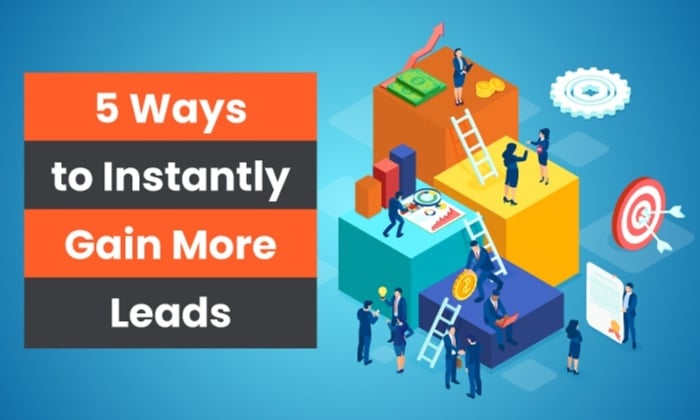
Finding prospective customers or “leads” for your business is no easy task. There’s a whole strategy involved, for one thing. You need to identify your target market, market your brand effectively, and create informative, appealing content for your chosen demographic.
What’s more, customers evolve, so you must constantly adapt your strategy to suit your customers’ expectations. As a marketer or entrepreneur, you can’t afford to rely on inefficient, outdated tactics like cold-calling and paying for leads. Instead, you need solid, proven techniques to draw in those all-important leads in an increasingly competitive digital world.
This is where I can help. Below, I’ll show you some techniques for getting more leads that actually work so you can successfully grow your business.
How Lead Generation Works
If you’re unfamiliar with lead generation, it’s a simple concept to learn.
Lead generation is a kind of “catch-all” term for the strategies you can use to generate new potential customers for your business. We can break the lead generation process into two parts.
First, you need to draw traffic to your website or social media platform. There are many ways you can do this, from paying for Google Ads or promoting your hashtags on social media.
Then, you want to convince these visitors to share some contact details with you, whether it’s an email address, telephone number, and so on. Once they share contact details with your marketing team, you can reach out to them and, hopefully, turn them into paying customers by the end of the sales funnel.
Does this mean you want as many leads as possible? Well, sure, but only within reason.
Think of it this way: Maybe you pay for 1,000 random leads, but only two of those individuals convert to paying customers. On the other hand, maybe you focus on running a high-quality marketing campaign that generates 20 leads, eight of whom become paying customers.
This is why I recommend you focus on organic lead generation rather than spending valuable marketing funds on ineffective tactics like paying for leads. With that in mind, let me show you how to get more quality leads rather than prospects that lead, well, nowhere.
5 Ways to Gain More Leads for Your Business
There are many ways to find new prospects and introduce people to your brand. What works for one business might not work for another, depending on your industry and commercial objectives.
To help you start on your lead-generation journey, here are five strategies that you can apply to businesses across a wide range of industries.
1. A/B Test Your CTAs
A call-to-action, or CTA, is a prompt that encourages someone to take a specific action. Examples of actions you might want your visitors to take include:
- signing up for a newsletter
- downloading a free product demo
- scheduling a call
- subscribing to a newsletter
- using a discount code
CTAs are a first step towards bringing people into your sales funnel, so it’s crucial you get them right. Ideally, your CTAs should be clear, emotive, and concise with strong action words. You might also include a visual element, depending on your audience.
Here’s an example from Officevibe, a team-building tool for businesses. In a blog post about one-on-one conversations, there’s a thought-provoking CTA that encourages readers to take the desired action i.e., click through to download a guide:
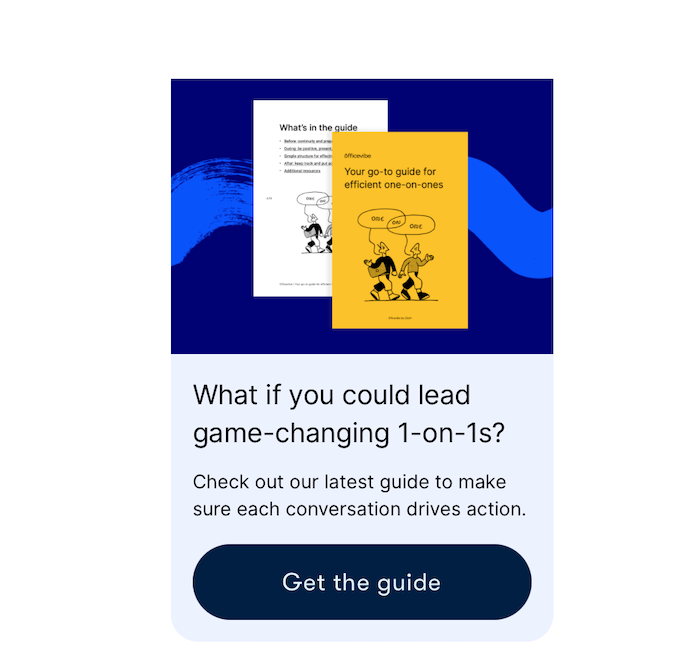
Now we’re a little clearer on what makes a good CTA, ask yourself this question: When was the last time you tested the effectiveness of your CTAs? Don’t worry if the answer’s “never,” because you can remedy that right now.
It all comes down to A/B testing.
A/B testing, or split testing, lets you compare different variations of the same marketing tool (e.g., a CTA button) to identify which version works best. Using the example above, you might change the wording “Get the guide,” or you might place the button at the bottom of the blog post rather than midway through the article.
Once you identify which version is most effective, you can easily generate more leads. Use tools like Google Analytics and my A/B testing calculator to measure your results.
2. Use User-Generated Content (UGC)
User-generated content is what it sounds like: content generated by users rather than businesses. UGC can be anything, such as:
- product reviews
- videos
- images or graphics
- audio
- articles or posts
UGC is marketing gold. Think of it this way: You didn’t pay for this content. It’s essentially free marketing for your brand. What’s more, it’s created by real people who love what you’re selling enough to tell other people about it. UGC, then, helps build your brand’s authenticity and trustworthiness online.
Want to use UGC for lead generation? If your reviews are generally positive, post them on your website to build a great brand impression and hopefully encourage visitors to complete an order. FITJEANS, for example, pulls product reviews from Trustpilot and publishes them on their homepage:
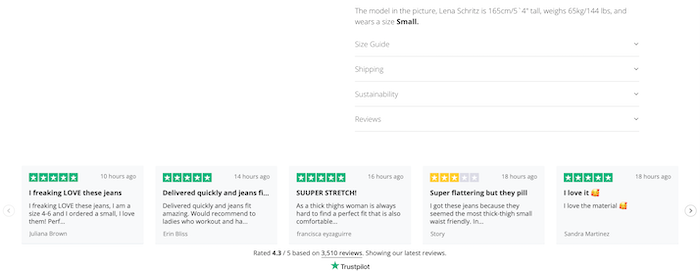
UGC can help your brand shine on social media, too. For example, you might also link to videos hyping your product or share pictures of people using your product (with their permission, of course.)
There are lots of ways to incorporate UGC into your brand, so don’t be afraid to get creative!
3. Host a Training Webinar
A training webinar is your opportunity to showcase your knowledge and experience. It also gives the impression that you’re prepared to share this knowledge for free, which helps foster trust in your company.
Hosting training webinars works in both the B2B and B2C space, depending on who your target market is. For example, if you’re a B2B company selling software to small businesses, you might host a product demo. Or, if you’re a B2C company selling cosmetics, you might host a webinar on how best to use your products.
Whether you’re in B2B or B2C marketing, the general steps for using training webinars for lead generation are the same.
First, advertise your webinar effectively. This might mean promoting your webinar on LinkedIn or talking it up on social media channels.
Next, make sure you get some details from interested parties, such as their email address. These contact details allow you to follow up with webinar attendees and, hopefully, nurture them along your sales funnel.
Also, you should use effective CTAs to encourage people to subscribe to your newsletter or follow your social media channels at the same time. A webinar is a great chance to introduce people to your product and your brand, so make the most of the opportunity.
Finally, keep the lines of communication open by inviting attendees to ask questions post-webinar or schedule a follow-up call.
4. Offer a Free Trial or Download
Just because a person visits your website or even subscribes to your content doesn’t mean they’re ready to purchase your product. How can you entice them to complete the sales process?
Try offering free trials or product downloads. Not only does this help people understand whether your product is right for them, but it fosters trust in your brand.
For example, I offer free seven-day trials for my SEO tools, which gives every user, from individuals to enterprises, a chance to experience my product first-hand and learn how it can help them:
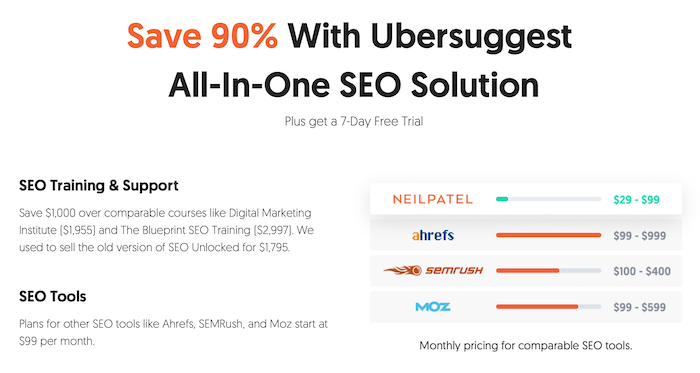
Just ensure your free trial gives people an accurate impression of how your app or software program works. If the product is too complex to understand on a trial basis, or if you’re only giving people access to a small part of the program for free, then the demo might not be enough to tempt your audience.
Alternatively, you can offer free downloads such as guides. For example, Merchant Maverick offers a free downloadable accounting guide, which could encourage users to trust the business and turn to them for more regular financial advice:
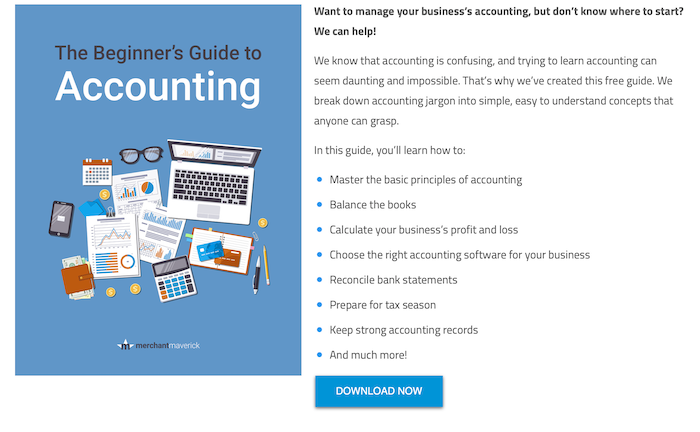
Share valuable knowledge for free, and hopefully, you’ll build a loyal following.
5. Partner With an Influencer
Influencers, or influential people, use their knowledge and popularity to persuade (or influence) their followers into using certain businesses. For example, influencers can encourage people to:
- try a new clothing brand
- download an app
- purchase a subscription box
- partner with a certain business
In the B2C realm, influencers often work on social media platforms. In B2B marketing, influential figures might include tech experts, analysts, and industry leaders.
No matter whether you’re in B2C or B2B marketing, though, influencers have a place, and you can use them for lead generation.
- First, set a goal for what you want to achieve, whether it’s promoting a specific product or enticing people to download your software. Determining the action you want people to take helps you identify who counts as a “lead” for your purposes.
- Next, find an influencer to partner with. For B2C marketing, you might check out social media or influencer marketing agencies. For B2B, pitch your product to experts and see if they’ll review it or host a chat with you about it.
Be sure to measure your campaign’s success and consider setting up a regular partnership if this strategy worked well for you.
Frequently Asked Questions About How to Gain More Leads for Your Business
OK, so those are five strategies you can use to quickly get more leads and attract new customers. However, we did cover a lot of ground there, so here’s a quick recap on lead generation:
What does it mean to generate more leads?
Lead generation is the process of finding potential new clients, customers, or subscribers. In other words, generating more leads means you’ve found more people to follow up with and, hopefully, convert into loyal subscribers or paying customers.
Are there ways I can get more leads for free?
Sure! Generate more leads for free by creating valuable content on a regular basis, making guest posts, and even asking existing customers for referrals. You might also ask clients to review your business on popular platforms, like Google, to increase your potential exposure without spending a dollar.
What are some outdated lead generations strategies I should avoid?
Well, first of all, paying for leads is a thing of the past. Now, it’s all about finding high-quality leads who are most likely to convert. Other techniques you want to avoid include aggressive cold calling or relying on just one strategy to generate leads. Effective lead generation is a complex process that requires the use of multiple marketing tools to succeed.
Do I need to use lead generation for my business to succeed?
Do you want new customers or subscribers? Do you want to grow your brand or company? If the answer’s yes, then you want to be out there generating leads! Otherwise, you’re missing out on a huge opportunity for finding potential business, which could frustrate your company’s growth in the long run.
How to Gain More Leads for Your Business: Conclusion
Lead generation is, essentially, a huge component of growing your business in the short and long term. That being said, you still want to focus more on the quality of your leads rather than the quantity. After all, the whole point of lead generation is to find new customers and grow your brand, so you want to throw your energy into the most promising prospects.
To be clear, though, you don’t need to restrict your efforts to the five options I outlined above. There’s a huge range of strategies for finding and nurturing business leads, and the ones that work for your business depend on your target audience and your commercial goals. Check out my consulting services if you need a little help with your lead generation strategy.
Have you tried any lead generation strategies for your business? Which ones worked best for you?
from Blog – Neil Patel https://ift.tt/3HCQcG5

No comments:
Post a Comment